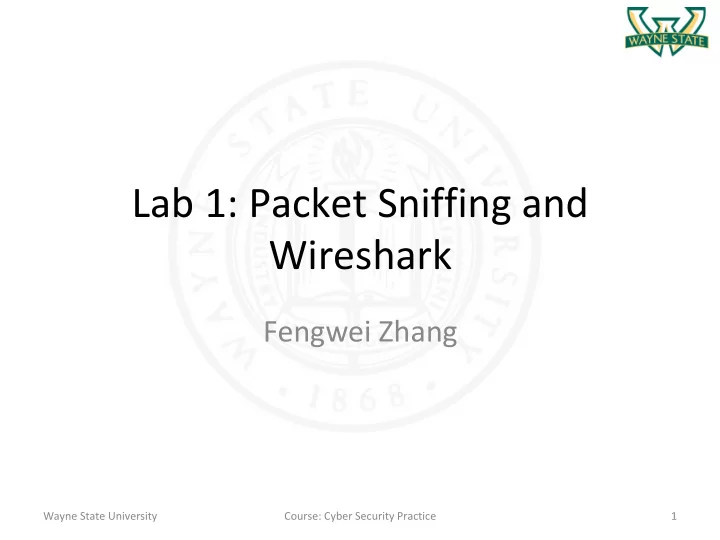

Lab 1: Packet Sniffing and Wireshark Fengwei Zhang Wayne State University Course: Cyber Security Practice 1
Packet Sniffer • Packet sniffer is a basic tool for observing network packet exchanges in a computer • Capturing (“sniffs”) packets being sent/received from/ by your computer • A packet sniffer itself is passive • Displaying the contents of the various protocol fields in these captured packets, but never sending packets itself Wayne State University Course: Cyber Security Practice 2
Packet Sniffer Structure Wayne State University Course: Cyber Security Practice 3
Packet Sniffer (cont’d) • Applications ( web browsers, FTP clients, email clients ) • Network protocols (Internet protocol) • Packet capture – The packet capture library receives a copy of every link-layer frame that is sent from or received by your computer • Packet Analyzer – Displaying the contents of all fields within a protocol message – Understanding the structure of all messages exchanged by protocols – IP, TCP, HTTP headers • Wireshark, TCPDump Wayne State University Course: Cyber Security Practice 4
TCP/IP Network Stack • TCP/IP is the most commonly used network model for Internet services. • Because its most important protocols, the Transmission Control Protocol (TCP) and the Internet Protocol (IP) were the first networking protocols defined in this standard, it is named as TCP/IP. • It contains multiple layers including: – Application layer – Transport layer – Network layer – Data link layer Wayne State University Course: Cyber Security Practice 5
An Example Layered Approach Wayne State University Course: Cyber Security Practice 6
Network Layers Wayne State University Course: Cyber Security Practice 7
Application Layer • The application layer includes the protocols used by most applications for providing user services • Examples of application layer protocols are Hypertext Transfer Protocol (HTTP), Secure Shell (SSH), File Transfer Protocol (FTP), and Simple Mail Transfer Protocol (SMTP) Wayne State University Course: Cyber Security Practice 8
Transport Layer • The transport layer establishes process-to-process connectivity, and it provides end-to-end services that are independent of underlying user data. • To implement the process-to-process communication, the protocol introduces a concept of port. The examples of transport layer protocols are Transport Control Protocol (TCP) and User Datagram Protocol (UDP). • The TCP provides flow control, connection establishment, and reliable transmission of data, while the UDP is a connectionless transmission model. Wayne State University Course: Cyber Security Practice 9
Internet Layer • The Internet layer is responsible for sending packets to across networks. • It has two functions: 1) Host identification by using IP addressing system (IPv4 and IPv6); and 2) packets routing from source to destination. • The examples of Internet layer protocols are Internet Protocol (IP), Internet Control Message Protocol (ICMP), and Address Resolution Protocol (ARP). Wayne State University Course: Cyber Security Practice 10
Link Layer • The link layer defines the networking methods within the scope of the local network link. • It is used to move the packets between two hosts on the same link. An common example of link layer protocols is Ethernet. Wayne State University Course: Cyber Security Practice 11
Data Encapsulation in Network Stack Wayne State University Course: Cyber Security Practice 12
Lab 0 • Make sure you can login as CSC 5290 student on Zero Client – Using your WSU access ID and password – Providing VM images for lab experiments Wayne State University Course: Cyber Security Practice 13
Lab 0 (cont’d) • Subscribe course mailing-list – csc5290@lists.wayne.edu – List Home page (web interface for subscribers to join/ leave list, post messages, view archives): http://lists.wayne.edu • Send an email to the list to introduce yourself by next class • Send a zipped test.txt file on Backboard by this week Wayne State University Course: Cyber Security Practice 14
Recommend
More recommend